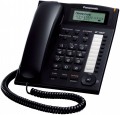Type
The type of phone primarily determines its purpose and features:
—
Stationary telephone. Also known as the landline phone.
It is the classic “home phone” which is most often installed in apartments for private use. This can be either a simple device with only purpose of making and receiving calls, or more complex device packed with features like display and an electronic notebook, a modern digital answering machine, a caller ID feature, etc.
—
System phone. More complex and multifunctional devices that can programme office mini-PBXs, organize conferences, switch incoming calls to internal network numbers, etc. Such devices are most often used in large offices.
Caller ID
Caller ID is a feature
of automatic identification of the caller's number. As soon as the phone receives an incoming call, this feature will immediately show the caller's number on the display, allowing the user to know who is calling even before he accepts the call. But at the same time, there is one nuance that many people omit: when you request a number from the PBX, the phone immediately establishes a connection, that is, from the same minute, the billing of the call begins for the subscriber at the other end of the wire.
Amount of numbers in memory
The maximum amount of phone numbers that a user can store in the phone's memory. To make a call to one of these numbers, you do not need to remember complex combinations of numbers, just select the desired contact and press the call button. Usually, the numbers that you have to use most often are stored in memory: numbers of family members, friends, etc.

